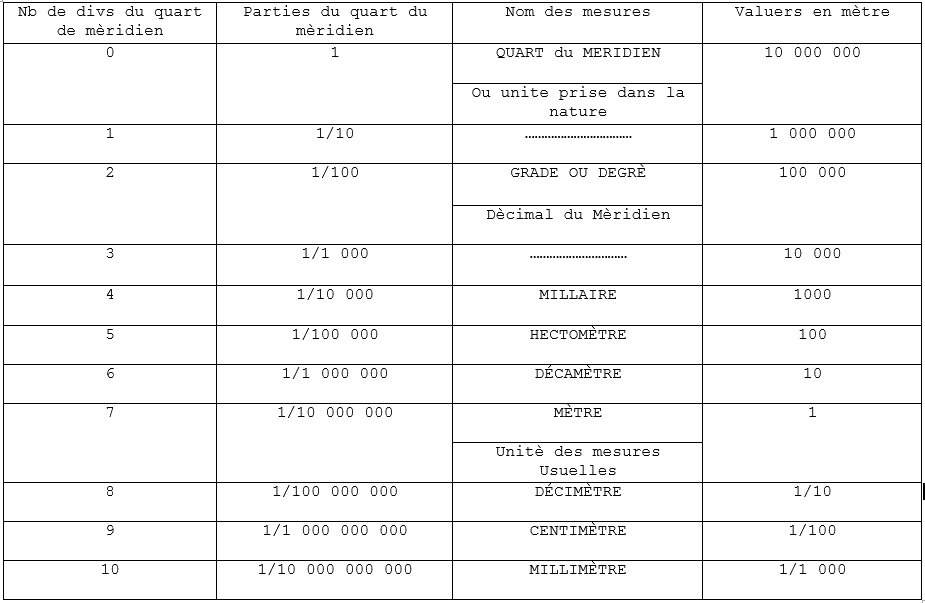kilometer on:
[Wikipedia]
[Google]
[Amazon]
The kilometre ( SI symbol: km; or ), spelt kilometer in American and Philippine English, is a unit of length in the
 By a decree of 8 May 1790, the French National Constituent Assembly ordered the
By a decree of 8 May 1790, the French National Constituent Assembly ordered the
International System of Units
The International System of Units, internationally known by the abbreviation SI (from French ), is the modern form of the metric system and the world's most widely used system of measurement. It is the only system of measurement with official s ...
(SI), equal to one thousand metre
The metre (or meter in US spelling; symbol: m) is the base unit of length in the International System of Units (SI). Since 2019, the metre has been defined as the length of the path travelled by light in vacuum during a time interval of of ...
s (kilo-
Kilo is a decimal prefix, decimal metric prefix, unit prefix in the metric system denoting multiplication by one thousand (103). It is used in the International System of Units, where it has the symbol k, in Letter case, lowercase.
The prefix ' ...
being the SI prefix for ). It is the preferred measurement unit to express distances between geographical places on land in most of the world; notable exceptions are the United States and the United Kingdom where the statute mile is used.
Pronunciation
There are two common pronunciations for the word. # # The first pronunciation follows a pattern in English whereby SI units are pronounced with the stress on the first syllable (as in kilogram, kilojoule and kilohertz) and the pronunciation of the actual base unit does not change irrespective of the prefix (as in centimetre, millimetre, nanometre and so on). It is generally preferred by the British Broadcasting Corporation (BBC), the Canadian Broadcasting Corporation (CBC), and the Australian Broadcasting Corporation (ABC). Many other users, particularly in countries where SI (the metric system) is not widely used, use the second pronunciation with stress on the second syllable. The second pronunciation follows the stress pattern used for the names of measuring instruments (such as ''micrometer'', ''barometer'', ''thermometer'', ''tachometer,'' and ''speedometer''). The contrast is even more obvious in countries that use the American spelling of the word ''metre''. This pronunciation is irregular because it makes the kilometre the only SI unit with the stress on the second syllable. After Australia introduced the metric system in 1970, the first pronunciation was declared official by the government's Metric Conversion Board. However, the Australian prime minister at the time, Gough Whitlam, insisted that the second pronunciation was the correct one because of the Greek origins of the two parts of the word.Equivalence to other units of length
:History
French Academy of Sciences
The French Academy of Sciences (, ) is a learned society, founded in 1666 by Louis XIV at the suggestion of Jean-Baptiste Colbert, to encourage and protect the spirit of French Scientific method, scientific research. It was at the forefron ...
to develop a new measurement system. In August 1793, the French National Convention decreed the metre
The metre (or meter in US spelling; symbol: m) is the base unit of length in the International System of Units (SI). Since 2019, the metre has been defined as the length of the path travelled by light in vacuum during a time interval of of ...
as the sole length measurement system in the French Republic and it was based on millionth of the distance from the orbital poles (either North or South) to the Equator
The equator is the circle of latitude that divides Earth into the Northern Hemisphere, Northern and Southern Hemisphere, Southern Hemispheres of Earth, hemispheres. It is an imaginary line located at 0 degrees latitude, about in circumferen ...
, this being a truly internationally based unit. The first name of the kilometre was "Millaire".
Although the metre was formally defined in 1799, the myriametre ( metres) was preferred to the "kilometre" for everyday use. The term "''myriamètre''" appeared a number of times in the text of Develey's book ''Physique d'Emile: ou, Principes de la science de la nature'', (published in 1802), while the term ''kilometre'' only appeared in an appendix. French maps published in 1835 had scales showing ''myriametres'' and "''lieues de Poste'' (Postal leagues of about metres).
The Dutch, on the other hand, adopted the kilometre in 1817 but gave it the local name of the ''mijl''. It was only in 1867 that the term "''kilometer'' became the only official unit of measure in the Netherlands to represent metres.
Two German textbooks dated 1842 Text version of Malaisé's book. and 1848 respectively give a snapshot of the use of the kilometre across Europe: the kilometre was in use in the Netherlands and in Italy, and the myriametre was in use in France.
In 1935, the International Committee for Weights and Measures (CIPM) officially abolished the prefix "myria-" and with it the "myriametre", leaving the kilometre as the recognised unit of length for measurements of that magnitude.
The symbol km for the kilometre is in lower case and has been standardised by the BIPM. A slang term for the kilometre in the US, UK, and Canadian militaries is '' klick''.
Kilometre records
Some sporting disciplines feature (one-kilometre) races in major events (such as theOlympic Games
The modern Olympic Games (Olympics; ) are the world's preeminent international Olympic sports, sporting events. They feature summer and winter sports competitions in which thousands of athletes from around the world participate in a Multi-s ...
). In some disciplines—although world records are catalogued—one-kilometre events remain a minority.
See also
* Conversion of units, for comparison with other units of length * Cubic metre * Metric prefix * Mileage * Odometer * Orders of magnitude (length) * Square kilometreNotes
References
External links
* {{SI units of length Metre +03 1000 (number)